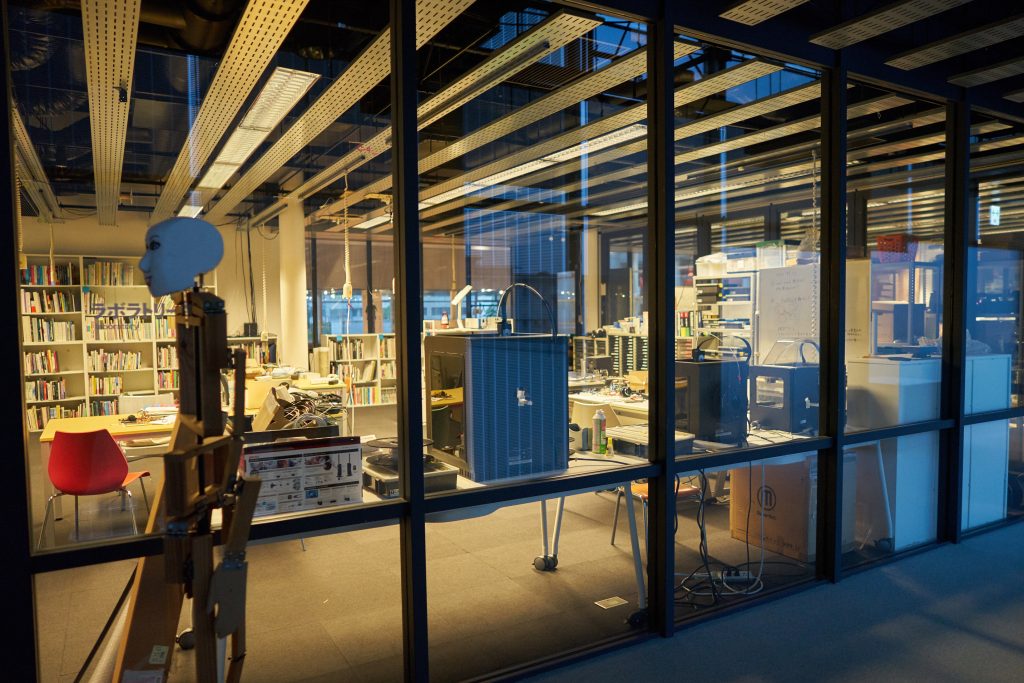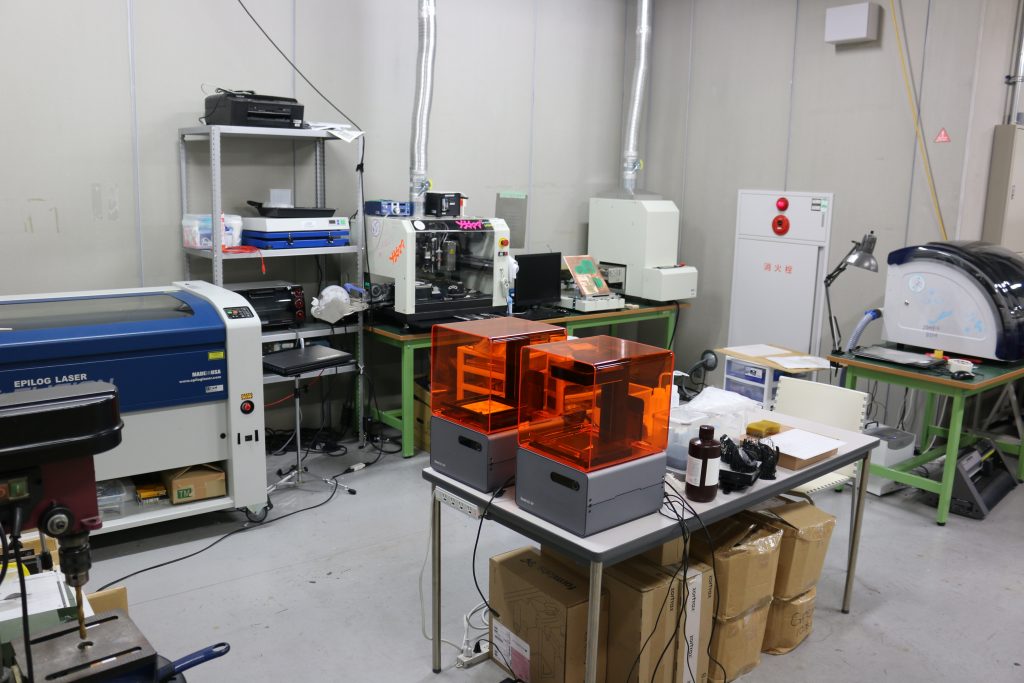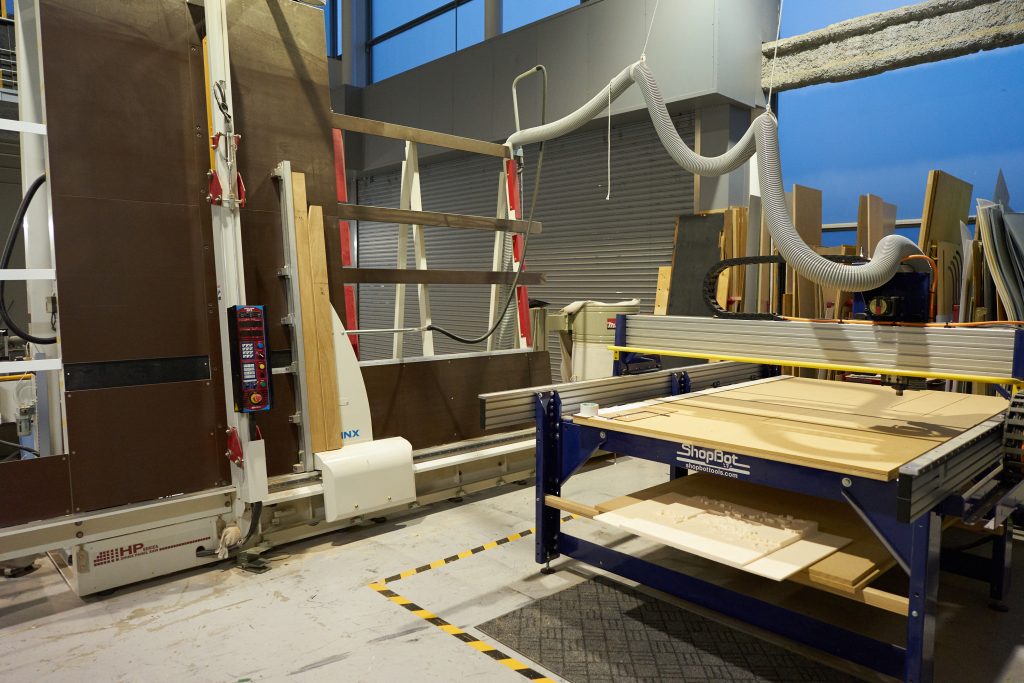
by Kazutoshi Tsuda,Mitsuhito Ando, Kazuhiro Jo & Takayuki Ito
The Yamaguchi Center for Arts and Media [YCAM] is a public art center located in Yamaguchi City, Japan. The center pursues new artistic modes of expression through the incorporation of media technology and hosts a diverse range of programs such as exhibitions, film screenings, workshops, performing art pieces and live events. Since its opening in 2003, the center has produced many art pieces, of which, over 40 pieces (such as Forest Symphony 2013, supersymmetry, 2014 Dividual Plays, 2015[1] and many more), has toured throughout the country, and exhibited in over 150 cities. At the core of the center is the concept of “Creating together, learning together.”
Photo by Eiji Ina
With the world transitioning to an information-driven society, from 1988 Yamaguchi City with a population under 200,000 was making plans for cultural facilities, and in 1993 the master plan for the center were drawn up. Arata Isozaki was selected as the architect, and he announced his design for the proposed cultural center in 1998. Thanks to Isozaki’s advice that the plan must include aspects of “Software” in addition to “Hardware”, several workshops were conducted among the invited curators and artists deliberating over how would the center be operated. After rigorous dialogue with the citizens, the creation of the center’s “initial configuration” was accomplished.
At the time of its opening, a prominent “Hardware” feature of the center was its layout of several functional facilities lined up side by side on a single shared platform, which offered versatility and flexibility in their capacity to be utilized according to it’s purpose and needs. A prominent “Software” feature was its centralization in “people”. With the concept of housing over 20 young and specialized staff members which include curators, educators, engineers, and designers, are producing diverse range of programs with the R&D process is possible. Such open collaboration between the artists (domestically and internationally) and the in-house team is a rare and unique example among existing theaters and art centers, especially among the Japanese art centers.
With the presence of the dedicated in-house team, the know-how acquired in the center’s design and production can be accumulated internally, and can facilitate a flexible adaptation and upgrading of equipment in response to the advancement of technology. Adjacent to the studios where artwork would be announced and displayed, were the lab spaces where art is designed and produced. Gradually, these functions of such spaces were expanded. While there were spaces for making electronics and wood work during the early years, by its 10th year, after 2013, the facility incorporated new equipments such as 3D printers and laser cutters[2] for digital fabrication. These advance the center’s development process for rapid prototyping by leaps and bounds.
The next good example, the incorporation of a PCB board plotter, chip mounter, and reflow oven. With such equipments in place, electronics prototype could be developed internally between the staff and artist. Even production orders of 1,000 units could now be handled in-house with only the circuit boards being outsourced for mass production (e.g. SWO stay, 2017).
For giant sculptures, in 2016, the center incorporated a large-format CNC router that played a big part in the creation of a specialized playground embedded with media technology (Korogaru garden, 2016). Thanks to the R&D framework curated within the span of the project, upgrades during the exhibition period were made possible. Such process successfully drew out the spontaneous and self-motivated expression from the participating adults and children[3]. In 2015, a bio lab space was established, incorporating field research and workshop development with the goal of integrating biotechnology into this expansion process (YCAM Bio Research, 2015-; DNA of Forests, 2016-).
With future efforts encompassing not only art, but an experimental prototyping along with the local community, the center’s role in developing the region has become much greater. In 2014, with the fab lab network and the local resources, the center took on the issues of challenging rural areas such as establishing pop-up fab labs in mountainous area of Yamaguchi City. Until now, YCAM has utilized its advantage as a public institution to further pursue R&D processes in hope for some new discoveries which could be beneficial and inspiring in contributing towards the arts, society and people. In order to develop further, starting in 2016 the center took its first steps towards becoming an academic research institute.
References
[1] Keina Konno, Richi Owaki, Yoshito Onishi, Ryo Kanda, Sheep, Akiko Takeshita, Tsubasa Nishi, Naoko Shiomi, Kyle McDonald, Satoru Higa, Motoi Shimizu, Yosuke Sakai, Yasuaki Kakehi, Kazuhiro Jo, Yoko Ando, Kazunao Abe, and Takayuki Ito. 2016. Dividual Plays Experimental Lab: An installation derived from Dividual Plays. In Proceedings of the TEI ’16: Tenth International Conference on Tangible, Embedded, and Embodied Interaction (TEI ’16). ACM, New York, NY, USA, 647-652. DOI: https://doi.org/10.1145/2839462.2856346
[2] Mitsuhito Ando, Chisaki Murakami, Takayuki Ito, and Kazuhiro Jo. 2016. Initial Trials of ofxEpilog: From Real Time Operation to Dynamic Focus of Epilog Laser Cutter. In Proceedings of the 29th Annual Symposium on User Interface Software and Technology (UIST ’16 Adjunct). ACM, New York, NY, USA, 175-176. DOI: https://doi.org/10.1145/2984751.2984756
[3] Daiya Aida, Kiyoshi Suganuma, Kazuhiro Jo, Kazunao Abe, The KOROGARU Park Series: Three Features of the Park of the Future. In: Proceedings of the 2017 Conference on Interaction Design and Children. ACM, 2017. pp. 379-384. , DOI: https://doi.org/10.1145/3078072.3079738
About the authors
Kazutoshi Tsuda is a researcher with a background in engineering and design. His research interests include personal fabrication, material cycles, and design for sustainability. He is a member of Fab Lab Japan Network, a co-founder of Fab Lab Kitakagaya, and also a local instructor of distributed education program Fab Academy (“How to Make Almost Anything”) and Bio Academy (“How to Grow Almost Anything”). After working as an assistant professor of engineering design at Osaka University, he is working as a researcher of “YCAM Bio Research” at Yamaguchi Center for Arts and Media [YCAM] since 2016.
Mitsuhito Ando works as hardware engineer at YCAM. He uses digital fabrication tools based on rapid prototyping for each project such as “Korogaru Koen Park” series, “Parallel Eyes” and ”AIDJ”. Through the prototyping, he exploring possibility of digital fabrication tool such as ”ofxEpilog” he developed. At Institute of Advanced Media Arts and Sciences (IAMAS) he has been researching the form of expression that utilizes digital fabrication tools applying rapid prototyping techniques. After graduating, he joined YCAM.
Kazuhiro Jo is a practitioner with a background in acoustics and interaction design. He has been presenting his practices in a form of works of art as at museums and festivals, as well as papers at international journals and conferences with his projects such as “The SINE WAVE ORCHESTRA”, “Generative Music Workshop”, and “phono/graph”. After working at IBM Japan, Newcastle University, Tokyo University of the Arts, and IAMAS, he took up his position as an associate professor in Faculty of Design at Kyushu University, Fukuoka, Japan as well as an advisor at YCAM.
Takayuki Ito is R&D Director of YCAM InterLab. He started to work for YCAM as a technical staff from 2003 and has since, worked with many productions of art installations, dance, live performances, educational programs and R&D projects. He has been leading “YCAM InterLab”, the R&D section for artistic/educational production as a director since 2011.





